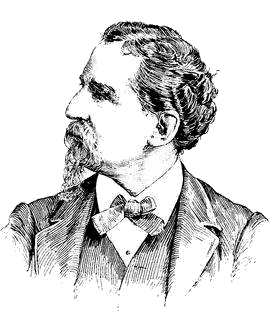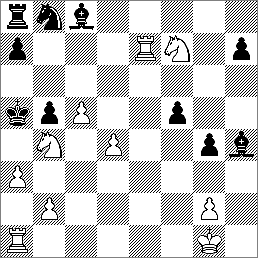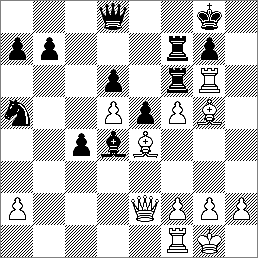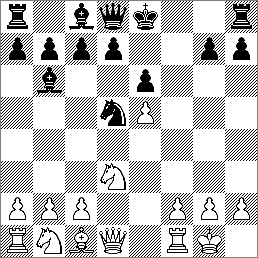The New York Times was not a newspaper with regular chess news in 1868. Just a few items appeared in the paper that year, but the match between George H. Mackenzie and Charles H. Stanley in December deserved three reports. The New York paper called the engagement between the two Englishmen an interesting match, which was arranged to inject interest in chess. Furthermore, the newspaper claimed in its report: "The forthcoming match is now the principal topic of discussion in chess circles."(1) Mackenzie and Stanley lived in New York; both men were regarded as the most popular players - and Mackenzie the strongest - of the city at that time.
A number of amateurs residing at the Maltby House, a hotel located on Great Jones Street near Broadway, hosted the match. The contest took place in the reading room of the hotel, and Colonel Bruce, the proprietor of the Maltby House, offered the prize of a board and set of chessmen. The games were played on the evenings of December 21, 22 and 26, 1868.(2) Mackenzie won the first game, Stanley the second. The decisive third encounter held no excitement because Stanley blundered early in the game.

Charles H. Stanley |
| | 1 | 2 | 3 | |
| Mackenzie | 1 | 0 | 1 | 2 |
| Stanley | 0 | 1 | 0 | 1 |
|

George H. Mackenzie |
According to Stanley, the match created considerable interest among the New York chess public, notwithstanding the facts that the combat was merely a short and friendly affair, and that the first Café Europa Tournament with 48 contestants was being held at the same time.(3)
| | |
| | Mackenzie,GH — Stanley,CH | Game 1 |
| C39 | King's Gambit Accepted: Kieseritzky (de Rivière) | |
| 1868.12.21 | USA New York (Maltby House) |
|
Annotations by Mackenzie (Turf, Field and Farm) and Stanley (The Round Table)
- 1.e4 e5 2.f4 exf4 3.Nf3 g5 4.h4 g4 5.Ne5 Nf6
- Mackenzie: Scarcely as good as Paulsen's move of 5...Bg7.
- 6.Bc4 d5 7.exd5 Bd6 8.d4 Qe7
- Stanley: It is difficult to say what Black's best course of play would now be. We should think, however, that 8...Nh5 would be preferable to the move just made.
- 9.Bxf4 Nh5 10.0-0 Qxh4
- Mackenzie: It is doubtful whether this or 10...Nxf4 is the better move.
- 11.Qe1
- Mackenzie: Major Jaenisch, in an analysis of this opening, published in the Chess Monthly for 1860, recommends here 11.Qe2, and breaks off with the remark that White has a good game.
- Stanley: A very powerful move, although at first sight it would not appear to be advantageous to exchange queens.
- 11...Qxe1 12.Rxe1 Nxf4 13.Ng6+ Kd7
- Mackenzie: 13...Be7 seems less disadvantageous.
- Stanley: To have interposed 13...Be7 would have been perhaps, less disastrous. Under existing circumstances, against the murderous precision of White's play, speedy defeat is inevitable.
- 14.Nxh8 f5 15.Nc3 c6 16.Nf7 Nxd5 17.Bxd5 cxd5 18.Nxd5 Bg3 19.Re7+ Kc6 20.c4 b5 21.Nb4+ Kb6 22.c5+ Ka5 23.a3 Bh4
 - Mackenzie: Black's pieces are so confined that the loss of the game is a mere question of time.
- 24.Re8 Bb7 25.Nd6 Be4 26.Rxe4 fxe4 27.b3 1-0
- Mackenzie: And mates next move.
- Stanley: And the mate with knight at b7 is forced in two moves.
Turf, Field and Farm, 1868.12.25
The Round Table, 1869.01.02
| | |
| | Stanley,CH — Mackenzie,GH | Game 2 |
| C51 | Evans Gambit: Morphy | |
| 1868.12.22 | USA New York (Maltby House) |
|
Annotations by Mackenzie (Turf, Field and Farm), Perrin (The Spirit of the Times), and Stanley (The Round Table)
- 1.e4 e5 2.Nf3 Nc6 3.Bc4 Bc5 4.b4 Bxb4 5.c3 Bc5 6.0-0 d6 7.d4 exd4 8.cxd4 Bb6 9.Nc3 Na5 10.Bd3 Ne7 11.d5 0-0 12.Bb2 Ng6 13.Ne2 f6 14.Qd2 c5 15.Rac1 Ne5 16.Nxe5 fxe5
- Stanley: It has always been a mooted question with which pawn to make this capture. There is much to be said pro and con for either.
- 17.Ng3 Bd7
- Mackenzie: 17...Rf4 strikes us as being a good move here.
- 18.Nf5 Bxf5 19.exf5 Rc8 20.Qe2 c4 21.Be4 Qh4
- Mackenzie: 21...Bd4, instead of this useless sally of the Queen, would have given Black a very fair game.
- Perrin: A weak move; 21...Bd4 would have been more to the purpose.
- Stanley: We are inclined to think that to this move Black may attribute the loss of the game, as it enables his opponent at once to bring queen's rook into play. The correct move in all probability would have been 21...Bd4.
- 22.Rc3
- Mackenzie: Mackenzie: The bringing of this rook into the field at the right moment wins the game for White.
- Perrin: Well played.
- 22...Bd4 23.Rh3 Qf6 24.Bc1 h6 25.Rg3 Rc7
- Mackenzie: Black can do nothing but await the oncoming of his adversary.
- 26.Rg6 Qd8 27.Bxh6
- Mackenzie: It matters little what he plays as the game is utterly hopeless.
- 27...Rf6 28.Bg5
- Perrin: Mr. Stanley takes every advantage of his opponent's error at the twenty-first move.
- 28...Rcf7
 - Stanley: Should White now continue 29.Bxf6, etc., he would win the exchange only, with a chance of winning the game more or less speculative.
- 29.Qg4 Rxg6
- Stanley: Against careful play Black's game is quite hopeless, and we doubt if he has at his disposal a better move.
- 30.fxg6 Rxf2 31.Rxf2 Bxf2+ 32.Kf1 Qf8 33.Qe6+
- Perrin: The coup de grace.
- 33...Kh8 34.Qh3+ Bh4+ 35.Bf5 1-0
Turf, Field and Farm, 1869.01.01
The Round Table, 1869.01.02
The Spirit of the Times, 1869.01.02
| | |
| | Mackenzie,GH — Stanley,CH | Game 3 |
| C50 | Italian | |
| 1868.12.26 | USA New York (Maltby House) |
|
Annotations by George H. Mackenzie (Turf, Field and Farm)
- 1.e4 e5 2.Nf3 Nc6 3.Bc4 Bc5 4.0-0 Nf6 5.d4 Nxd4
- The best move we believe to be 5...Bxd4, with the following continuation: 5...Bxd4 6.Nxd4 Nxd4 7.f4 d6 8.fxe5 dxe5 9.Bg5 Be6.
- 6.Nxe5 Ne6 7.Bxe6 fxe6
- Obviously he dare not take with queen's pawn.
- 8.Nd3 Bb6 9.e5 Nd5
 - This loses a piece; but in any case, owing to his faulty play on the fifth move, Black must have a bad game.
- 10.c4 Ne7 11.c5 0-0 12.cxb6 axb6 13.Bg5 Qe8 14.Nc3 Ng6 15.Nb5 Qf7 16.Nxc7 Rb8 17.Nb5 Qf5 18.f4
- Threatening to win the queen.
- 18...Qe4 19.Re1 Qd5 20.Nd6 h6 21.f5 exf5 22.Nf4 Qc5+ 23.Kh1 Nxe5 24.Rc1 Qa5 25.Rxe5 Qxe5 26.Ng6 Qe6 27.Nxf8 Kxf8 28.Bf4 g5 29.Qd4 gxf4 30.Qh8+ Ke7 31.Nxc8+ Rxc8 32.Qxc8 1-0
Turf, Field and Farm, 1869.01.01
The Albion, 1869.01.02
- (1) New York Times, December 20, 1868. The other two reports appeared in the papers of December 23 and 27, 1868.
- (2) Turf, Field and Farm, December 25, 1868
- (3) The Round Table, January 2, 1869
© 2011 Joost van Winsen. All rights Reserved.
|
